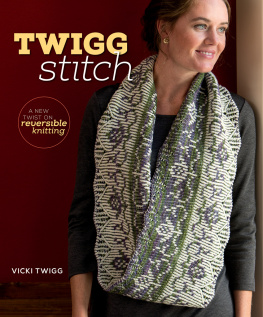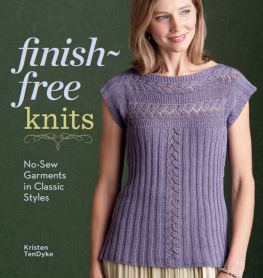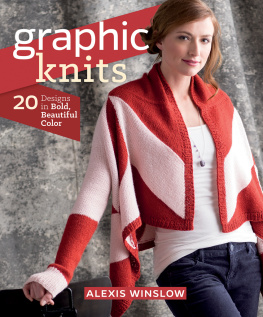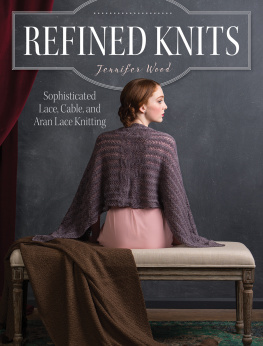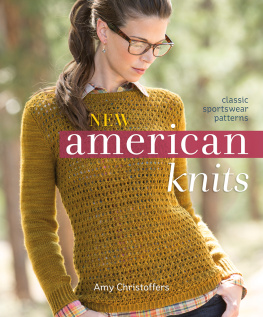

BRAVE
NEW
KNITS


CONTENTS

FOREWORD
T he book youre about to enjoy explores a topic thats near and dear to me: the mingling of knitters and the Internet. When my husband, Casey, and I started Ravelry more than three years ago, I was just one of thousands of knit bloggers, trying to keep up with all the crafty things happening online. I had no idea our little site would blossom into the community it has become. But I couldnt be more thrilled that this is where we ended up.
I guess you could say Ravelry started with my need for a hobby. I taught myself to knit in 2004 with a little help from my local yarn shop andI admit itKnitting for Dummies. I was quickly hooked, despite making a tragic hat that would fit no living human. Naturally, I wanted to find other people who knit, too. One day Casey happened upon a knitting blog, which led him to another, and then another. We were amazed at how many knitters were blogging! I began following many of these blogs, and I even made friends from around the world along the way. Soon I wanted a blog, too, so Casey and I teamed up to make frecklegirl.com, where I started writing in May 2004.
There was just one problem with my newfound knitting community: The amount of inspiration and information available through it was staggeringand completely scattered. The only way to keep up was with an overloaded RSS reader and many, many bookmarks.
After a while I became frustrated with this inadequate system of organization, and who got to hear about it more than Casey? He started talking casually about how it could be neat to have an online database of pattern and yarn information that linked blogs and Web sites together. It would have to be easy to search, simple for users to make contributions, and, of course, pretty, with photos of projects and yarn. I really liked the idea, so we started playing around with it. We posted a mock-up of what the site would look like on my blog, and the positive feedback it received encouraged us to keep going.
When we first opened Ravelry to test among my knitting and blogging friends, it was far from finished. Fortunately, this didnt affect their ability to understand where we were headed. Timing was everything; a lot of them were comfortable with collaborative and social Web sites, so we didnt really have to explain things, like why we put so much emphasis on public sharing or connecting things like patterns and people.
Ravelry, like many grassroots organizations, evolved through the contributions of the community it was designed to serve. Our early test group helped us see the sites potential and motivated us to quickly make improvements and open it up to a broader audience. Before we knew it, we had more users than we ever dreamed of, functions we might never have thought up on our own, and just the right place for me to satisfy my urge to meticulously organize all my yarn, needles, projects, patterns... well, you get the picture.
One of the things that makes us so proud of Ravelry is how it has helped independent designers bring their creations to a large, concentrated audience. Its astounding how many patterns exist in the world. Really, with online self-publishing, nearly anyone, from casual dabbler to professional, can put a pattern out there. But on Ravelry, designers can promote their work and build a community around it. In essence, they can create a name for themselves without a magazine, book publisher, or yarn company backing up their work. That said, this isnt an issue of traditional publishing versus shiny, new, electronic publishing. Books and magazines havent become irrelevant; they just have to bend a little to the new, ever-changing publishing landscape.
Considering how the yarn-loving community has embraced Ravelry, it might seem as if we have a secret code for what works for knitters online and why. We dont. While there is something a little magical about how the social Internet and old-school yarn crafts made such a strong connection, the phenomenon is also somewhat ordinary. Today, creative types from every discipline use the Internet to create their personal brands, self-publish their work, and communicate directly with their fansjust like designers do on Ravelry. People seem to crave real, personal connections with the businesses and artists they support. And knitters and crocheters, I am proud to say, seem to be at the front of this new wave, with young and old joining the online ranks every day.
As far as craft and the Internet and Ravelry and where its all headedhonestly, I dont know for sure. But if Ravelry has revealed anything, its that our community is full of creative and passionate people who are ready to contribute and try new things. Any of them could be the next breakout designer, blogger, and yarn-dyer... and we cant wait to see what they do next.
Jessica Marshall Forbes
Cofounder of Ravelry.com

INTRODUCTION
W hen I discovered the blogosphere in general and knitting blogs in particular in 2005, the wonders of this brave new online world seemed overwhelming. Although I was elated to find a passionate, like-minded community that shared my obsession with all things knitting-related, it was also a shock to realize that I was so late to the party. As I tumbled excitedly down the rabbit hole of knitting blogsbecause each new discovery led to yet another, equally captivating onethis universe expanded to include online patterns, amazingly comprehensive YouTube technique tutorials, and, of course, fiber shopping opportunities to supplement the offerings at my local yarn shop.
But best of all were the personalities I encountered on these blogsthe dozens of knitters who share everything from their latest stash enhancements to swatching conundrums, from works in progress to finished projects, from personal triumphs and tragedies to political and philosophical musings. Whether a blogger writes from Boston or San Francisco, New York or New Mexico, Canada or Finland, each invites me into the worldand the lifehe or she inhabits. I meet his pets, her children; I discover her favorite yarns and patterns, his latest how-did-I-ever-survive-without-it toolsall with a click of the mouse.
I became a devoted lurker on my favorite blogs, bookmarking them so I could check in weekly (and sometimes, I confess, daily) on what these bloggers were making and what was happening in their lives. I began to feel as if I knew them; their words seemed as familiar as those of old friends, even though most details of their personal lives unfolded tantalizingly off the page.
Many of my favorite bloggers were also designers, and much of what fascinated me about their blogs had to do with their latest creations. Their styles and design preferences were as diverse as their blog personalities. Reading the details of their projects, I sympathized with their creative challenges and marveled at their sources of inspiration (nature! architecture! science!). It was fascinating to read their impressions of the yarns they chose for their projects and why. Their exacting standards and technical expertise both impressed and inspired me, and the humor with which they described their not-always-successful knitting experiments made them and their commentary seem all the more grounded and human.
Next page

